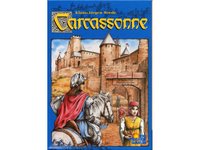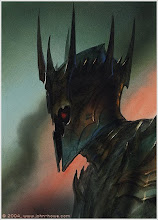There are no Carcasses in Carcassonne! (wait, there is one...)

If I keep buying boardgames at this rate, I'll be broke by KublaCon.
I bought a new one today: Carcassonne! I will have to say one thing about euro-games, they're elegant. No masses of armies scrunched up at the border of some unpronouncable province ready to pounce upon the opponent with a flurry of die rolls that are as abstract as cubist art. Not that there's anything wrong with that...
The two games I have heard every boardgamer geek proclaim to the skies as 'god given'... actually, three games (so that we have a trinity, get it?) are Settlers of Catan, Carcassonne, and Puerto Rico. I finally own two of them. Puerto Rico is coming....
Let's take a look at Settlers vis-a-vis Carcassonne: They are both tile games in that the board game is made of tiles that change after each session. With Settlers these are hexagons, Carcassonne has square tiles. But Settlers has a locked game-field whereas the board in Carcassonne can go anywhere, much like dominoes. In fact, Carcassonne has many similarities with dominoes in that there is a kind of 'boneyard' where the tiles yet to be played reside. Each player draws one and must play it (or else discard it from the game if there is no way to play it - this situation is rare). Each square tile is animorphic, that is, they are made to fit together but only in certain ways. As each tile's four sides end in either a road, city or field the odds of finding one that fits in any given board setup is 100% in most cases. One gets the feeling that you're constructing a spontaneous jigsaw puzzle with the notable exception that you have a stake in how the board ends up. You see, you have 8 followers. These are wooden stylized men painted in one of five colors (red, yellow, green, blue and black. They add grey in the Inns & Cathedrals expansion set which I will get into later). And after you place your tile on the table, connecting to another tile already in play you can place one of your followers on the tile you just laid. Now if this follower is in a city segment, it's a knight; if it's on a road, it's a thief; and if it's in a field, it's a farmer. However, if you have a follower in a cloister, then it's a monk. This nomenclature is really academic and serves to only add immersion factor to the 'medieval' theme the game evokes. The important thing to note is if a city, road or cloister is 'completed' - i.e. the surrounding tiles create a finished, whole city, for example, then the follower is put back into your supply and you are awarded victory points. Cities can be the biggest scorers with cloisters coming in second. Roads are the real wild card as their length determines their victory point worth, so it behooves one to make as long a road as possible if you have a thief on that road.
If you are confused with what I typed above, then you are a normal person. We boardgame geeks get a little 'into it'. As with most games, it is easier to learn the rules by playing the game with experienced persons rather than reading some yahoo's rendition of the rules. Be that as it may, the rules are quite simple and guess what? No dice! This is really a fun game with the only random factor being which tile you happened to draw.
My version of Carcassonne has a set of 12 river tiles added as a 'free expansion'. I have played with the river tiles and I really don't understand why one would use them. I saw no difference in game play except that the board looks cooler when 'A River Runs Through It'.
Sorry.... I thought that was funny. Guess not.
Settlers of Catan had me hooked (what am I saying? It still does!). As my previous post can attest, I even bought the computer game to bone up on my Catan mad skillz. I tried desperately to get my family to play this game (even bought the 5-6 player expansion set just in case) and again, I might as well have had Roy Batty stick his replicant thumbs through my eyeballs while I recite the mantra of 'Brick and Lumber make a Road' over and over while three monkeys from Java stick a white-hot poker up my kiester while simultaneously summoning Sweeney Todd, the Demon Barber of Fleet Street, to slice my throat and send me down his barber chair chute to be the mystery meat in the next pot pie he makes for public consumption, rather than have ANYONE play a GAME of ANYTHING with me. Was I a tad harsh? Nah...
Actually, my cousins played a couple games of Munchkin with me, so that was cool. Especially when I won both games.
Anyway, the point is, I didn't play it this past Easter weekend. But! I did play it with a woman named Audrey and a couple of teenagers at Hobbytown USA this past Friday. Now, as a preface I should say that this Audrey was the same person who recommended this game to me. I should also note that this same Audrey RESOUNDINGLY KICKED MY ASS at Settlers of Catan.
Twice.
This is what I get for listening to 'recommendations'. This is like going into a chess store and having Gary Kasparov recommend the 'Naploeon Set' and then when he offers to play a game with you he mates you in twelve. Gee, I feel better about this $220 purchase. Thanks Gary!
Thanks Audrey!
Of course, this is all comic hyperbole. I enjoyed the game and the chance to finally play it with human beings. My errors were in initial placement. Something that will be certainly corrected at our next meeting.
But in Settlers of Catan, there are a pair of six-sided dice which determine which hex tiles produce resources (wool, brick, lumber, ore and grain) also known as (sheep, clay, wood, mines, and wheat). Don't ask me why people do this. I said DON'T! And those resources are used to build roads, settlements and cities. These, in turn, award victory points (there's that dreaded euro-game element again). Ten victory points is Victory! The game is one of probabilities and odds. As any craps player can tell you, the two dice produce a bell curve with 2 and 12 having one possibility in 36 and a 7 having a hefty 6 chances in 36. To further make this basic statistic plain to even the most mathematically inept player, the makers of the game have made the 6 and 8 bright red in color. These numbered tiles are placed on the hex tiles during board setup in a set sequence (the number tiles have letters on them and you place them in alphabetical order counter-clockwise on the hex tiles). Now each different hexagon (hills, mountains, fields, pastures and forests) has a probability attached to it as to how often that hex will produce the given resource. Got it? Good. Being that each player starts with two settlements and two roads, and each settlement is worth 1 victory point each, that means each player needs to accumulate only 8 more to win. There are no battles or skirmishes in Settlers of Catan. The closest thing to anything resembling combat is the Largest Army card which grants you 2 victory points.
So, how do these games rank against each other - or even objectively?
I would have to give Settlers of Catan 5 of out of 5 meeples. It has good replay value, little to no downtime due to the extensive trading going on between players even when it's not their turn. No sleepytime here, bucko! You snooze, you lose. Not to mention the savvyness of being shrewd on trading and being stalwart on your choices. Wavering in your plans can get you in last place pretty easy.
Carcassonne... I give it 5 out of 5 meeples as well. It also has superb replay value. Downtime is not a factor of constant interaction as it is in Settlers, but the turns are so fast plus you do have a say in where others' tiles may end up that it would behoove you to pay attention during an opponent's turn. (I mean, why would you not? If your TV is on during a boardgame, I would recommend turning it off. I mean completely off. Unplug it and chuck it out the plate-glass window. Please).
Hope this helped. Next time, I'll deal with the Inns & Cathedrals expansion for Carcassonne and the 5-6 player expansion for Settlers of Catan.


0 Comments:
Post a Comment
<< Home